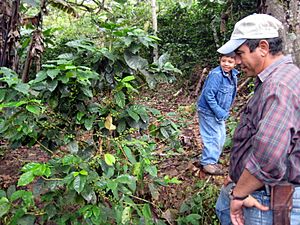Coffee production in Nicaragua facts for kids

Nicaragua is a country in Central America, and coffee production has been a really important part of its history and economy. It's one of the main things Nicaragua produces and sells to other countries. The best places to grow coffee are usually in areas like Matagalpa and Jinotega. Coffee grows best about 800 meters (about half a mile) above sea level.
Contents
A Look Back: Coffee's Story in Nicaragua
How Coffee Growing Started
Large-scale coffee growing began in Nicaragua around the 1850s. By 1870, coffee had become the most important crop the country exported. It stayed in that top spot for the next 100 years!
Growing coffee is a lot of work. Coffee trees need several years to grow before they can produce beans. The whole process of growing coffee also needs a lot of money, workers, and land. Coffee plants also grow best in rich soil from volcanoes, usually found in mountains. This can make it tricky to get the coffee beans to the market.
Coffee Production in the Past
In 1891, Nicaragua produced over 11 million pounds (about 5 million kilograms) of coffee. About 76,000 acres (30,750 hectares) of land were used to grow it. This meant each acre produced about 1,102 pounds (1,235 kilograms per hectare) of coffee.
The main ways to transport coffee for export were by train and by steamship. The National Railroad took coffee from Granada to Corinto on the Pacific coast. Steamships carried coffee from Lake Nicaragua and the San Juan River to the Atlantic Ocean.
The government of Nicaragua wanted more coffee farms. They even offered a prize of 5 cents for every coffee tree planted on farms with more than 5,000 trees! Most of Nicaragua's coffee was sent to Europe because shipping to the United States was more expensive. Also, coffee sold for a higher price in Europe.
In 1900, Nicaragua's coffee crop was about 150,000 bags, which was double the amount from the year before. The money from coffee export taxes was around $300,000. That year, Nicaragua exported over 1.4 million kilograms (about 3.2 million pounds) of coffee through ports like El Castillo and Bluefields. This coffee was worth about $295,348.
Modern Coffee Farming
By 1992, more land in Nicaragua was used for coffee than for any other crop. The amount of land used for coffee changes a bit each year, but in the 1980s, it was about 2,100 square kilometers (518,921 acres). Most coffee is grown in the northern central highlands and in the hilly volcanic areas around Jinotepe.
Even though coffee production dropped a little in the late 1980s, the 1989 crop was still about 42,000 tons (46,297 short tons). Nicaragua's transportation system isn't always the best, and there are concerns about growing too many crops on volcanic slopes. These challenges limit how much more coffee can be grown. Because of this, farmers are looking into growing other crops in different parts of the country.
New Coffee Plants
In 2019, scientists from CIRAD (an international research center) developed a new type of coffee tree in Nicaragua. It's called Starmaya. This new tree is special because it can be grown from seeds in special gardens. Starmaya coffee trees are strong! They can resist a plant disease called rust. They also produce great-tasting coffee at high altitudes and give a lot of coffee beans.

